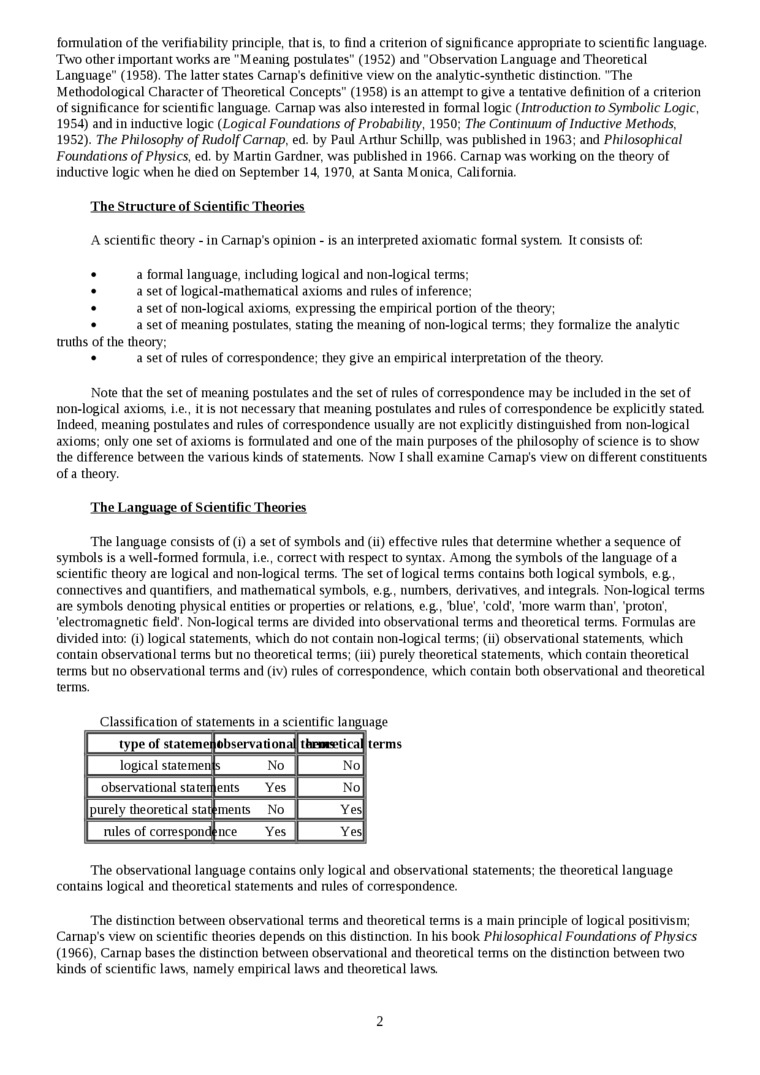104299

fonnulation of the verifiability principle, that is, lo fmd a criterion of signifirance appropriate to scientific language. Two oilier important works are "Meaning postulates" (1952) and "Observation Language and Theoretical Language" (1958). Tlie latter States Camap's definitive viewon tlie analytic-syiithetic distinction. "The Metliodological Cliaracter of Theoretical Concepts" (1958) is an attempt to give a tentative dehnition of a criterion of significance for scientific language. Camap was also interested in fonnal logie (Introduction to Symbolic Logic, 1954) and in inductive logie (Logica\ Foundations of Probability, 1950; The Continuum oflnductive Metłtods, 1952). The Philosoplry of Rudolf Camap, ed. by Paul Arthur Schillp, was pubUshed in 1963; and Philosophical Foundations ofPhysics, ed. by Martin Gardner. was published in 1966. Camap was working on tlie tlieory of inductive logie when he died on September 14. 1970. at Santa Monica, California.
JUie.SiruLtur.fi olSdenŁilicJJieoiies
A scientific theory - in Camap's opinion - is an interpreted axiomatic format system. It consists of:
• a formal language, induding logical and non-logical terms;
• a set of logical-mathemańcal axioms and rules of inference;
• a set of non-logical axioms, expressing tlie empirical portion of the tlieory;
• a set of meaning posmlates, stating the meaning of non-logical terms; tliey formalize the analytic
trutlis of the theory;
• a set of rules of correspondence; tliey give an empirical interpretation of tlie theory.
Notę that the set of meaning postulates and the set of rules of correspondence may be induded in tlie set of non-logical axioms, i.e., it is not necessary that meaning posmlates and rules of correspondence be explicitly stated. Indeed, meaning posmlates and rules of correspondence usually are not explicidy distinguished from non-logical axioms; only one set of axioms is formulated and one of the main purposes of the philosophy of science is to show the difference between tlie various kinds of statements. Now I sliall examine Camap's view on different constiments of a theoiy.
IhŁLflJPS^
The language consists of (i) a set of symbols and (ii) effecńve rules that determine whether a sequence of symbols is a well-foimed formula, i.e., correct witli respect to syntax. Among tlie symbols of the language of a scientific theoiy are logical and non-logical terms. Tlie set of logical terms contains botli logical symbols. e.g, connectives and quantifiers, and matliematical symbols. e.g.. numbers. derivatives. and integrals. Non-logical terms are symbols denoting physical entities or properties or relations. e.g. 'blue'. cold'. morę warm ihan’. 'proton', 'electromagnetic field'. Non-logical terms are divided into observational terms and theoretical terms. Formulas are divided into: (i) logical statements, whicli do not contain non-logical terms; (ii) obseivational statements, which contain observational terms but no theoretical terms; (iii) purely theoretical statements. which contain theoretical terms but no observational terms and (iv) rules of correspondence. which contain both observational and tlieoretical terms.
Classification of statements in a scientific
|
type of stateme |
6bservationa |
thranMira | |
|
logical statemen |
s No |
No | |
|
obsemtional sta ter |
ents |
Yes |
No |
|
purely tlieoretical stat |
ments |
No |
Yes |
|
rules of correspond |
nce |
Yes |
Yes |
kingiage terms
The observational language contains only logical and observational statements; the tlieoretical language contains logical and theoretical statements and rules of correspondence.
The distinction between observational terms and tlieoretical terms is a main principle of logical positivism; Camaps view on scientific tlieories depends on tliis distinction. In his book Philosophical Foundations of Physics (1966). Carnap bases the disiincdon between obsemtional and theoretical terms on the distinction between two kinds of scientific laws, namely empirical laws and theoretical laws.
2
Wyszukiwarka
Podobne podstrony:
The aim of the reform is to change fundamentally the present status of the working man, that is to e
lnvoking MySQL Programs To invoke a MySQL program from the command linę (that is, from your shell or
The MySQL Database Server is very fast, reliable, scalable, and easy to use. If that is what you are
Ask Me EverythingQ How deep is the GrandCanyon? The canyon is a gigantic gash in the Arizona Desert
cproxy 3 FTP Options -X] Set the FTP Port that will be used for REAL Ftp clients to allow data trans
cproxy 3 FTP Options -X] Set the FTP Port that will be used for REAL Ftp clients to allow data trans
Flower Motif to Appliąue Thls flower motif mtulrcs a bu of pallonce lo make. bul that is woli w
ILS signals This way State is maintained Altitude is lo Horizontal flight, it waits for the -fact
00365 m2e8679c0886ed1125ed5bcd4590b4c 369 Regret Indices and Capability Quantification a power of 2
21 In principle the agglomeration of the nomands is not large, it counts some twenty to eighty perso
en borders, might get better then. Add fire place where the last ray of faith in lost on purpos
więcej podobnych podstron